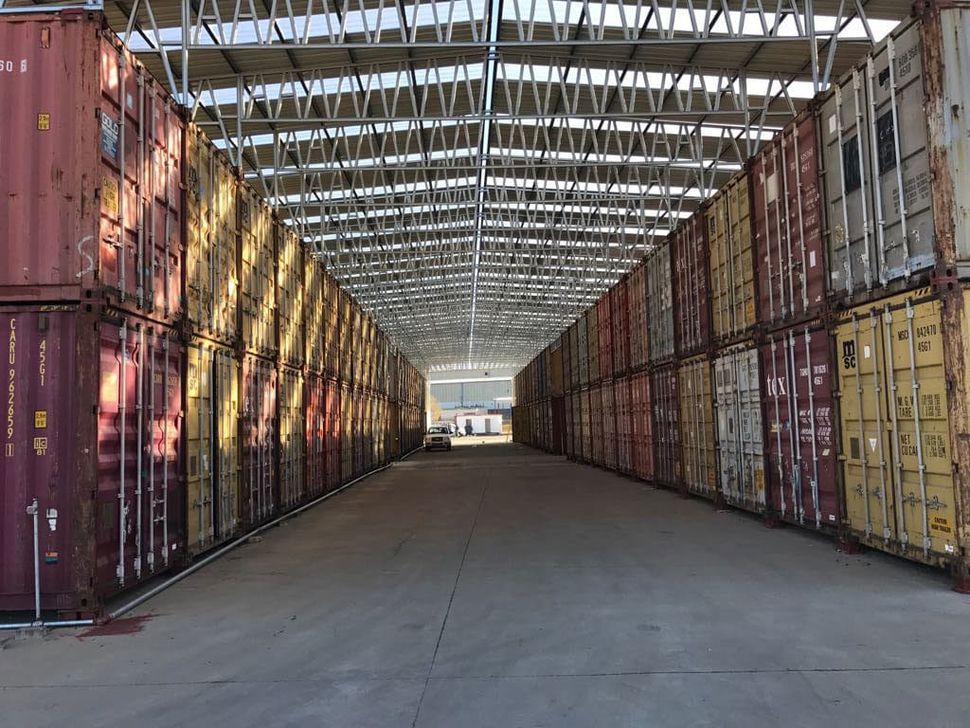Methods for stacking shipping containers during warehousing

The ubiquitous distribution of container transportation has led to the emergence of specialized terminals with appropriate equipment for handling and storing large-tonnage containers. At the same time, clear storage rules were created to optimize the use of existing space.
Sea container terminals
Taking into account the large size of containers, terminals for their processing have impressive dimensions. According to the standard, to accommodate 150 TEU (container in a 20-foot equivalent), at least 0.4 hectares of territory are required.
The standard container terminal in the port has:
- a berth for handling container ships: one or three berths with a front width of 15-50 meters;
- technological area for moving containers;
- rear cargo front for handling road and rail transport;
- picking warehouses for filling / unloading containers (often moved outside the terminal);
- repair and maintenance area;
- office and household premises.
In turn, the technological sites are divided into several zones with specialization:
- storage of containers;
- conducting inspection operations;
- reception and delivery of containers;
- moving equipment to the mooring front.
Depending on the equipment of the terminal, it has video surveillance, weighing equipment, radio communications, reading and scanning devices.
Rules for stacking large-capacity containers:
- storage is carried out in accordance with technological maps and schemes approved in a particular port;
- storage height up to 5 tiers, but in each port is determined individually, taking into account the capabilities of transshipment equipment and the permissible loads of the sites;
- for empty containers, stacking without additional fastening is allowed with a height of no more than two tiers to exclude the risk of overturning in bad weather;
- for stacking with manual installation of containers in a bundle, there are ledges with a height of 1 tier to ensure the safety of personnel;
- loading / unloading and storage processes are maximally mechanized using mobile gantry cranes, reachstackers and other machines.
Container storage schemes in ports
At present, container terminals used several schemes for placing goods:
Band
Used when performing work with portal loaders. In this case, the containers are arranged in long lines at the end of each other, at an angle of 90 degrees to the cordon or parallel to it if the width of the warehouse is insufficient. The minimum number of containers in a row is from 8 units with an increase to 80-90 pieces. The longer the belt, the higher the skill level of the forklift drivers is required. The minimum gap between containers on the side is from 1.27 meters, from the ends - a maximum of 0.3 meters. Stacking in height is carried out no higher than three tiers, depending on the capabilities of a particular terminal.
The technique is used mainly for the outgoing stream, when each tape is created for a certain direction of work.
Tower
The use of this scheme provides for the presence of loaders equipped with side grips. Stacks are formed in 2 rows of 8-12 containers each. The width of the passage between the rows is from 4 meters and more for the possibility of vehicle passage and maneuvering.
The height of storage is no more than two tiers, leaving free spaces in the towers for convenient handling of containers. The scheme is mainly in demand for incoming cargo flow with small processing volumes.
Both of the above options can be used to handle refrigerated containers, as they provide convenience for connecting to power grids and monitoring the set temperature.
Blocky
The scheme is adapted for the operation of gantry cranes or forklift trucks with side grips. The containers are placed in rows with minimal lateral gaps between them and the modules are placed at the end of each other. The block length is determined by the dimensions of the storage area. The height of the stacks is up to 3 tiers for loaded containers and up to 5 tiers for empty containers with appropriate fastening.
Trailer
This scheme is used at terminals handling vessels by unloading trailer bogies loaded / unloaded onto RO-RO vessels (with horizontal loading). The basis for placing trailers with containers is the principle of access to them by port and truck tractors used to transport bogies.
Transverse
The scheme is typical for working with reusable containers in the absence of a stable outgoing cargo flow. The placement of stacks is provided across the quay front, which makes it possible to reduce the number of passages to the quay for port equipment, increasing the area of areas used directly for warehouse storage of goods.
Longitudinal-transverse
It is used for uniformity of incoming and outgoing cargo flow. Containers are assembled for storage in blocks with stacks arranged longitudinally and perpendicular to the quay front. For longitudinal rows, it is used by alternating containers of import and export directions. This arrangement allows you to optimize work, while simultaneously handling container ships, road and rail transport without interfering with each other.


